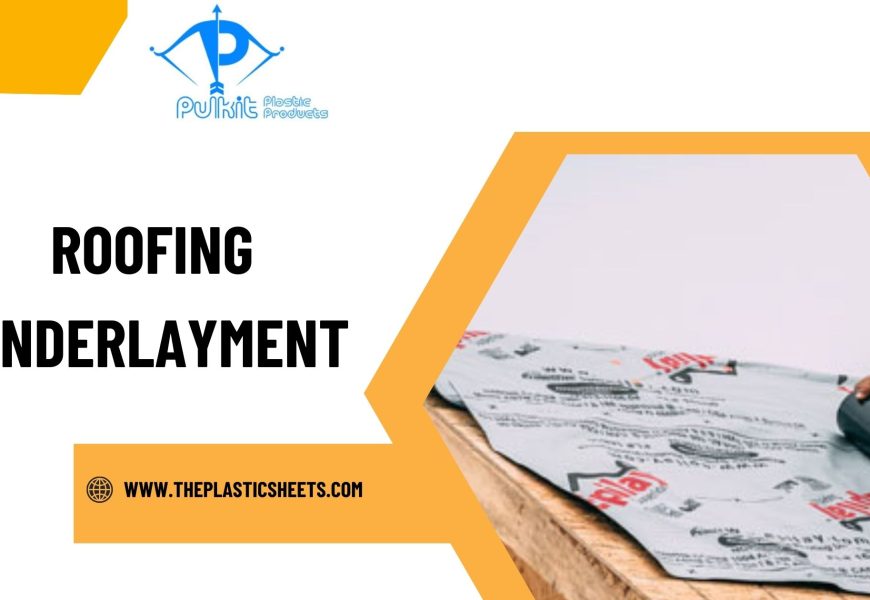When it comes to roofing, the primary focus often centers on the shingles or tiles that adorn the top of your home. However, an equally vital but often overlooked component is roofing underlayment. This material acts as a protective barrier under the primary roofing layer, offering enhanced durability, moisture protection, and overall structural integrity. In this article, we’ll delve deep into roofing underlayment materials, exploring their types, benefits, and specific applications, including the best options for metal roofs, along with the options available in India. We will also mention reliable suppliers like Pulkit Plastic Products, which provide high-quality roofing materials.
What is Roofing Underlayment?
Roofing underlayment is a water-resistant or waterproof barrier that is installed directly onto the roof deck before the main roofing material is applied. The importance of underlayment lies in its role as an additional layer of protection against water infiltration and damage. Other benefits include:
- Moisture Control: Prevents moisture build-up, reducing the risk of mold and mildew, which can lead to serious structural issues.
- Protection from Ice Dams: For areas prone to freezing temperatures, underlayment can help mitigate ice dam formation.
- Enhanced Roof Longevity: Quality underlayment can extend the life of the roofing system by providing an extra layer against the elements.
Types of Roofing Underlayment Materials
There are a variety of underlayment materials available, and choosing the right one depends on factors such as roofing type, climate, and budget. Here’s a breakdown of the most common types:
1. Asphalt-Saturated Felt
Felt underlayment is one of the oldest and most traditional materials used in roofing. It is made from paper that has been saturated with asphalt, making it water-resistant.
- Pros: Cost-effective and easy to install.
- Cons: Less durable than other types and vulnerable to tearing. Over time, felt can decay if exposed to water long-term.
2. Synthetic Underlayment
Synthetic underlayment is made from engineered materials that offer improved water resistance and durability compared to felt. It is lighter, easier to work with, and less prone to tearing.
- Pros: More robust than felt, offers excellent traction, and is generally more resistant to UV rays.
- Cons: Higher initial cost than felt options.
3. Rubberized Asphalt Underlayment
This type consists of a sticky, rubberized asphalt layer and provides excellent waterproofing capabilities. It is often used in areas that require superior performance, particularly in climates with heavy rainfall or snow.
- Pros: High durability and excellent waterproofing.
- Cons: Typically more expensive and requires careful installation.
4. Ice and Water Shield
Usually installed in vulnerable areas like eaves, valleys, and around chimneys, ice and water shield underlayment features a self-adhesive backing, ensuring it adheres tightly to the roof deck.
- Pros: Offers superior protection against ice dams and heavy rainfall.
- Cons: Usually more expensive and not necessary for all roof applications.
5. Roof Underlayment for Metal Roofs
For homeowners considering Roof Underlayment For Metal Roofs materials are designed to withstand the unique challenges posed by metal roofs. A quality underlayment for metal roofs should be moisture-resistant, lightweight, and able to provide sound dampening.
Key Features Include:
- Thermal stability to prevent deterioration from heat.
- Compatibility with reflective surfaces found in metal roofs.
Choosing the Best Roofing Underlayment
When determining the Best Roofing Underlayment, consider the following factors:
- Climate Conditions: In regions prone to heavy rain or snow, a higher-grade underlayment, such as rubberized asphalt or synthetic options, is advisable.
- Roofing Material: The type of primary roofing material—whether it be asphalt shingles, tile, or metal—can influence your choice of underlayment.
- Budget: While it might be tempting to cut costs with low-grade materials, investing in quality underlayment can save money in the long run by enhancing your roof’s lifespan.
- Installation: Some materials require professional installation, while others are DIY-friendly.
Roof Underlayments in India
Roof Underlayments in india market is diverse, with various options available for different climates and structures. Manufacturers and suppliers focus on producing underlayments that cater to local environmental needs.
Pulkit Plastic Products is one such supplier, specializing in high-quality roofing materials. They offer a range of underlayment options suitable for various types of roofing systems, ensuring that building and construction projects receive durable and reliable materials.
Conclusion
Roofing underlayment is an integral part of a comprehensive roofing system. By understanding the types, benefits, and applications of underlayment materials, homeowners and builders can make informed decisions that enhance the longevity and functionality of their roofs.
From traditional asphalt-saturated felt to advanced synthetic and rubberized materials, there is an underlayment type to meet every need, including specific solutions for metal roofs.
Whether you’re a homeowner, contractor, or builder in India, it’s essential to partner with dependable suppliers like Pulkit Plastic Products, who offer quality roofing underlayments designed to perform under varying environmental conditions.
Investing in the right roofing underlayment is about more than immediate appearance; it’s about ensuring long-term protection against nature’s elements and securing the structural integrity of your home for years to come.
FAQs
Q1: What is the purpose of roofing underlayment?
A1: Roofing underlayment acts as a water-resistant or waterproof barrier protecting your home from moisture infiltration and damage, thereby extending the life of the roof.
Q2: How long does roofing underlayment last?
A2: The lifespan of roofing underlayment depends on the type of material used, but most quality underlayments can last 20 years or more when properly installed and maintained.
Q3: Is underlayment necessary for metal roofs?
A3: Yes, while metal roofs are durable, using the appropriate underlayment helps prevent moisture buildup and enhances the roof’s overall performance.
Q4: Can I install roofing underlayment myself?
A4: Many types of roofing underlayment can be installed as part of a DIY project, particularly synthetic options. However, rubberized and specialized underlayments are best installed by professionals.
Q5: What are the best roofing underlayment materials for extreme weather?
A5: For extreme weather conditions, rubberized asphalt and high-performance synthetic underlayments provide enhanced water and ice resistance, making them ideal for areas with heavy snow or rainfall.









